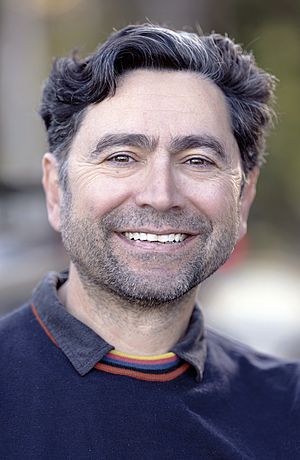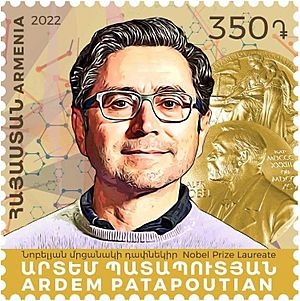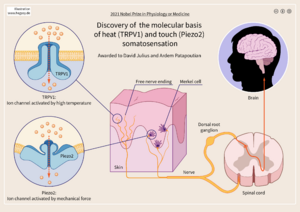Ardem Patapoutian facts for kids
Quick facts for kids
Ardem Patapoutian
|
|
|---|---|

Patapoutian in 2022
|
|
| Born | 1 October 1967 Beirut, Lebanon
|
| Citizenship |
|
| Alma mater | American University of Beirut University of California, Los Angeles (BS) California Institute of Technology (MS, PhD) |
| Known for | research of PIEZO1, PIEZO2, TRPM8 receptors |
| Children | 1 son |
| Parent(s) | Sarkis Vahakn |
| Awards | Nobel Prize in Physiology or Medicine (2021) |
| Scientific career | |
| Fields | Molecular biology, neuroscience |
| Institutions | Scripps Research |
| Thesis | The role of the MyoD family genes during mouse development (1996) |
| Doctoral advisor | Barbara Wold |
Ardem Patapoutian (born October 1, 1967) is a famous scientist from Lebanon and America. He is a molecular biologist and neuroscientist. He also won a Nobel Prize.
Dr. Patapoutian is known for finding special sensors in our bodies. These sensors are called PIEZO1, PIEZO2, and TRPM8 receptors. They help us feel things like pressure, cold (from menthol), and temperature. He works as a professor at Scripps Research in La Jolla, California. In 2021, he shared the Nobel Prize with David Julius for their amazing discoveries.
Contents
Early Life and Education
Ardem Patapoutian was born in Beirut, Lebanon. His family is Lebanese Armenian. His father, Sarkis Patapoutian, was a poet and an accountant. His mother, Haiguhi Adjemian, was a school principal. He has a brother named Ara and a sister named Houry. His grandparents moved to Lebanon after surviving the Armenian Genocide.
He went to Armenian schools in Beirut. He studied at the American University of Beirut for one year. In 1986, he moved to the United States. He earned a Bachelor of Science (B.S.) degree in biology from the University of California, Los Angeles in 1990. Then, he got his PhD in biology from the California Institute of Technology in 1996. His teacher there was Barbara Wold.
After his PhD, Dr. Patapoutian worked at the University of California, San Francisco. In 2000, he became a professor at the Scripps Research Institute. Since 2014, he has also been a researcher for the Howard Hughes Medical Institute (HHMI).
Personal Life
Dr. Patapoutian is now a citizen of the United States. He lives in Del Mar, California with his wife, Nancy Hong. She is a venture capitalist, which means she invests in new businesses. They have one son named Luca.
Discovering How We Feel Touch and Temperature
Dr. Patapoutian's research helps us understand how our bodies sense temperature and touch. This knowledge can lead to new ways to treat problems like chronic pain. His discoveries showed how heat, cold, and pressure create signals in our nerves.
Finding the PIEZO Channels
Dr. Patapoutian and his team looked for genes that control our sense of touch. They found a gene that made cells unable to feel touch. They named the sensor controlled by this gene PIEZO1. The word "piezo" means "pressure."
They then found another similar gene and named it PIEZO2. This ion channel is very important for our sense of touch. PIEZO1 and PIEZO2 channels also help control other body functions. These include blood pressure, breathing, and bladder control.
Other Important Discoveries
Dr. Patapoutian also found other ion channels and sensors. These are activated by temperature, pressure, or changes in cell size. His work showed that these channels are key for feeling temperature and touch. They also help with proprioception, which is knowing where your body parts are. They play a role in feeling pain and controlling blood vessels.
Awards and Honors
Dr. Patapoutian has received many awards for his scientific work. He became a member of the American Association for the Advancement of Science in 2016. He also joined the National Academy of Sciences in 2017. In 2020, he became a member of the American Academy of Arts and Sciences.
He received the Kavli Prize for Neuroscience in 2020. He also won the BBVA Foundation Frontiers of Knowledge Award in Biology / Biomedicine.
In 2021, he won the Nobel Prize in Physiology or Medicine with David Julius. They were honored for finding the receptors that help us feel temperature and touch.
In October 2021, the President of Lebanon, Michel Aoun, gave him the Lebanese Order of Merit. In December 2021, he received the Golden Plate Award from the Academy of Achievement.
In 2022, the Carnegie Corporation of New York named him a "Great Immigrant."
Recognition in Armenia
Ardem Patapoutian is the first Armenian Nobel laureate. He received a warm welcome when he visited Armenia in June 2022. The Prime Minister, Nikol Pashinyan, gave him the Order of St. Mesrop Mashtots. The Armenian National Academy of Sciences made him an honorary member. The Yerevan State Medical University gave him an honorary doctorate. Dr. Patapoutian gave a copy of his Nobel medal to the History Museum of Armenia. The Armenian postal service, HayPost, even issued a stamp honoring him.
See also
 In Spanish: Ardem Patapoutian para niños
In Spanish: Ardem Patapoutian para niños



